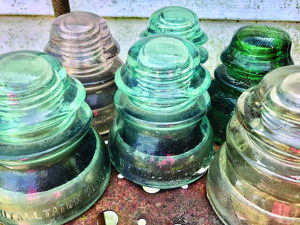(Editor’s note: DeeDee Wood is the owner of Black Cat Curiosities, an online antiques research and sales venue.)

Many people collect insulators that are unusual and are in different, rare colors. The predominate colors of historic insulators were aqua and clear, and often were made from leftover materials from existing creations the companies were used to making, such as aqua canning jars, clear glassware of all types, and more. (Photo courtesy DeeDee Wood
Glass insulators are collected by antique enthusiasts for use in DIY home décor, seaside blues and greens themes, decorations for people who like Americana and Rustic décor and more.
What is an insulator, and what were the actual uses of these unusually shaped, important part of our 1800s emerging communications history in this country?
In 1844, Samuel Morse, famous now for “Morse Code”, used the first telegraph machine, and by the 1850s, wires for telegraphs and their important messages were being strung up across the United States. Glass insulators, a small, beehive-shaped glass object, “insulated” the current running through the lines and wires.
They sat atop telegraph, and later, phone and electric lines, and were attached to the poles and wooden structures that ran lines through them, often following railroad lines that zigzagged through the countryside of this early country.
The glass connections to the wires helped the current of communication stay strong and steady, thus helping the messages reach their destinations more readily.
Industrial techniques became more advanced over time, and as the manufacturing and process of telephone and electrical systems joined telegraph wiring and communications needs across the country at the turn of the century, these glass insulators became larger to hold more wiring systems, had to be reliable to still maintain a strong current for communication, and were beginning to be manufactured by a larger group of glass makers in the industry who also produced other glass objects.
In the 1930s, with the passage of the Rural Electrification Act, which provided funding and accessibility of electricity and telephone lines in those types of systems in rural areas, the need for these glass insulators became even more in demand, and became a specialized product to produce.
Companies, who often times also made other glass items in their factories, such as Depression glass, fruit jars, dishes, decorative objects and household goods, also received contracts from electric and wiring companies to manufacture insulators for their booming business.
Names found on some of these insulators by collectors today would include Indiana Glass, Hemingway, Whitall and more. A true, antique insulator had these names of manufacturers stamped on the bottom edges of the insulator and are easily recognized.
Many people collect insulators that are unusual and are in different, rare colors.
The predominate colors of historic insulators were aqua and clear, and often were made from leftover materials from existing creations the companies were used to making, such as aqua canning jars, clear glassware of all types, and more.
The unusual color schemes came from old bottles and medicine glass, and now and then an insulator can be found in purple or “amethyst” as it was called, yellow, and even red.
Any color that strays from the basic aqua, green and clear are rarer and more sought after by collectors.
The glass insulator industry reached its peak during the Great Depression Era of the 1930s, and continued on until the 1950s, when porcelain insulators, a better conductor of electricity, were being more readily utilized by electrical systems and companies for reliability and modernization.
As the communications systems in general went from wiring to cable lines, (cable doesn’t need insulators to hold a current), the glass creations and problem solvers were no longer needed.



